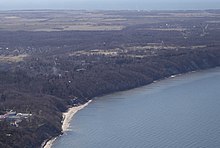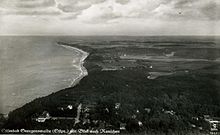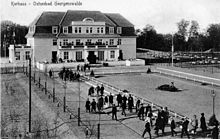Otradnoye (Kaliningrad, Svetlogorsk)
| district
Otradnoje / Georgenswalde
Отрадное
|
||||||||||||||||||||
|
||||||||||||||||||||
|
||||||||||||||||||||
Otradnoje ( Russian Отрадное ; German Georgenswalde ) is a district of Swetlogorsk (Rauschen) and belongs to the Kaliningrad region in Russia .
geography

Otradnoje is located west of Svetlogorsk and east of Warnicken (now Russian: Lesnoje) on the northern coast of the Samland . The northern coast of the Samland near Georgenswalde is a steep coast with deep gorges (Detroit Gorge, Gausup Gorge, Blaue Rinne and Wolfsschlucht). To the west, south and east Georgenswalde was surrounded by approx. 2000 hectares of dense mixed forest.
history



Georgenswalde was created on July 7th, 1629 by the award of 5 Hufen and 22 acres (296 hectares) of undeveloped land by Elector Georg Wilhelm as hereditary property to the Warnick wilderness rider Caspar Cawemann as thanks for many years of loyal service. Cawemann is said to have saved the life of his electoral lord when he was attacked by a bear while hunting. The area assigned to him lay between the “Gerge” or “Görge” in the south, the fishing village of Warnicken in the west and the Baltic Sea to the north. It is unclear whether the property was initially named "Georgenwalde" after "Elector Georg" or after "Görge", which later became "Georgenswalde".
A hunting lodge built in 1618 was converted into a manor house by Caspar Cawemann and expanded by his heirs. This property was farmed until 1945.
The owners of the Georgenswalde estate were:
- 1629–1676 Caspar Cawemann and his son
- from 1677 Henning Weydemeyer (beach rider)
- (in the following years the owners are not known)
- 1778–1793 Johann Friedrich Bergau
- 1793–1829 Ernst Bergau (Chamber Calculator)
- 1829–1853 Johann Friedrich Bergau (Government Secretary)
- 1853–1870 Friedrich Wilhelm Julius Bergau (City Treasurer)
- 1870–1873 Friedrich Heinrich Gaedecke (Secret Commerce and Admiralty Councilor), Adolf Aron Moses Aronson (businessman) and Gustav Simon (businessman)
- 1873–1878 Friedrich Heinrich Gaedecke (Secret Commerce and Admiralty Council )
- 1878–1902 Friedrich August Neumann (estate manager)
- 1902–1907 Artur Neumann (estate manager)
- 1907 Acquisition by Landbank AG Berlin, division of the site
- 1908–1917 Rudolf Bergau
- 1917–1945 Waldemar Rade
In 1908, Landbank AG Berlin divided the 296 hectare site into an estate (221 hectares) and a development area of 75 hectares for the establishment of a villa colony and a seaside resort.
In 1908 the land bank divided the area of the villa colony into 400 parcels. A generous road network and several public spaces were planned and created. By 1910, 16 houses and a central waterworks had already been built. In the following years construction began on a large scale. A modern Kurhaus was built by 1914, the train station was massively expanded and a post office was set up. Now the number of villas and holiday homes grew rapidly and with the increasing number of residents and the influx of guests, merchants also settled and opened shops. Guesthouses, inns and other shops followed in the 1920s. Numerous Königsberg personalities, doctors, civil servants, merchants, officers and artists settled in the Baltic Sea resort of Georgenswalde or built mostly winter-proof holiday homes. The place grew steadily until the late 1930s.
Although the Second World War slowed this upward trend, the place remained largely unaffected by the effects of the war until 1944. In the summer of 1944, as a precautionary measure, clinics were relocated from Königsberg to Georgenswalde to the “Vier Jahreszeiten” and “Samlandheim” guest houses due to the approaching front line. In August Königsberg was destroyed by a British bomb attack. Numerous surviving Königsbergers found protection in their Georgenswald summer houses. From autumn 1944 refugees came from the eastern districts of East Prussia.
After a first brief breakthrough by the Red Army in early February 1945, Georgenswalde was finally occupied by the Red Army on the evening of April 14, 1945. The place was almost undamaged up to this point. A large number of the residents began to flee westwards.
After the Second World War, the Baltic Sea resort came to the Soviet Union and was renamed Otradnoye. The remaining residents were evacuated and the new residents came from different parts of the Soviet Union.
Georgenswalde district (1930–1945)
After the forest estate district of Warnicken was incorporated into the rural community of Georgenswalde on December 1, 1928, the Warnicken district was renamed to "Georgenswalde district" on May 18, 1930 and the official seat was relocated accordingly. The district belonged to 1939 to the county Fischhausen from 1939 to 1945 County Samland in the administrative district of Konigsberg the Prussian province of East Prussia . The administrative district only included the rural community Georgenswalde.
Infrastructure
Before 1914 the water supply of the place with a 45 high water tower was completed. In the autumn of 1928, the construction of a sewerage system began and the roads were paved.
church
Georgenswalde belonged together with 27 other small parishes to the Protestant parish of Sankt Lorenz (today Russian: Salskoje) in the parish of Fischhausen (Primorsk) within the church province of East Prussia of the Church of the Old Prussian Union . From April 1, 1929, the new parish Rauschen was formed from Rauschen with Sassau and Cobjeiten and Georgenswalde with Warnicken and Hirschau, which, however, remained in the network of the church in Sankt Lorenz. Today Otradnoye is in the catchment area of the Evangelical Lutheran Church of the Resurrection in Kaliningrad (Königsberg) within the Kaliningrad provost of the Evangelical Lutheran Church of European Russia .
school
Until 1913, the Georgenswald children went to school in Rauschen. In 1913, Landbank AG Berlin built a school building with a classroom and a teacher's apartment. On May 1, 1913, the number of students was 61. In 1926, the school building was expanded when there were 80 students.
Clubs (until 1945)
(Year of foundation, name, goals of the association)
- 1912 Grundbesitzerverein Georgenswalde eV (promotion of tourism, proof of housing, legal representation towards Landbank AG)
- 1912 war club (dissolved in 1919, re-established in 1922)
- 1923 Betriebswerk Georgenswalde eGmbH (establishment and operation of an electrical low-voltage network in Georgenswalde)
- 1929 Verschönerungsverein Georgenswalde eV (maintenance of public spaces, signposting and maintenance, organization of folk festivals)
traffic
Since 1900 Georgenswalde was the train station of the Samland Railway from Königsberg to Warnicken. It was less than an hour away for the Königsberg townspeople to go swimming. The station was shut down around 2006. Today the travel time Kaliningrad - Otradnoye is about 30 minutes.
Coastal defense
The steep coast near Georgenswalde is endangered by erosion. Without human intervention, an average of around 50 cm of cliff was removed each year. At the end of the last ice age, the coastline was about 3 km further north than it is today. In 1925, the "Samländischer Küstenschutz" association began building groynes and the streams in the hinterland were canalized, which led to the stabilization of the cliffs and widening of the beach from 10 to 40 meters. This work was not continued after 1945. Most of the groynes are in ruins today. Therefore, the beach is only about 5–10 meters deep today and has completely disappeared in some places.
Brachert Museum
For the German sculptor Hermann Brachert it has been located at 7 Tokarew Street in Otradnoye since 1993
an art museum in memory of him and his work. The building is the former summer house of the Brachert family, which was converted into a residential building by Hanns Hopp in 1937 .
Son of the community
- Wolfgang Schulz (1943–2015), art historian
Web links
- Article Otradnoye in the Great Soviet Encyclopedia (BSE) , 3rd edition 1969–1978 (Russian)
Individual evidence
- ^ Rolf Jehke, Warnicken / Georgenswalde district
- ↑ Evangelical Lutheran Provosty Kaliningrad ( Memento of the original dated August 29, 2011 in the Internet Archive ) Info: The archive link was inserted automatically and has not yet been checked. Please check the original and archive link according to the instructions and then remove this notice.
- ^ W. Tschernjajew: The Russian Museum of the German artist. In: Bernstein in the work of Hermann Brachert. Kaliningrad 2015. ISBN 978-5-903920-34-1 .





